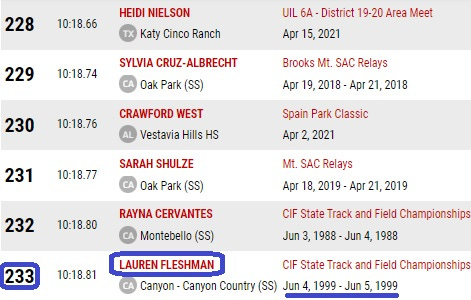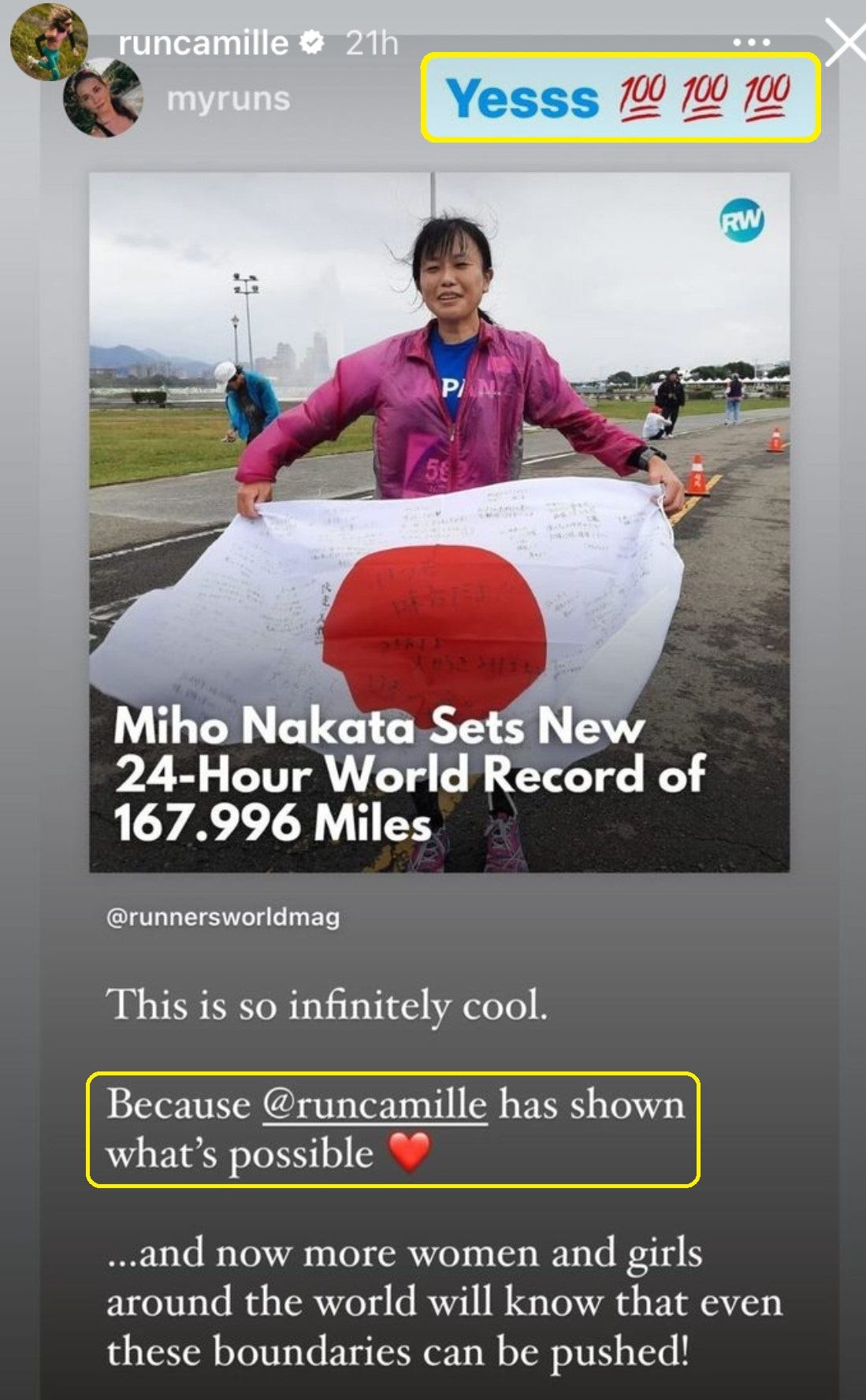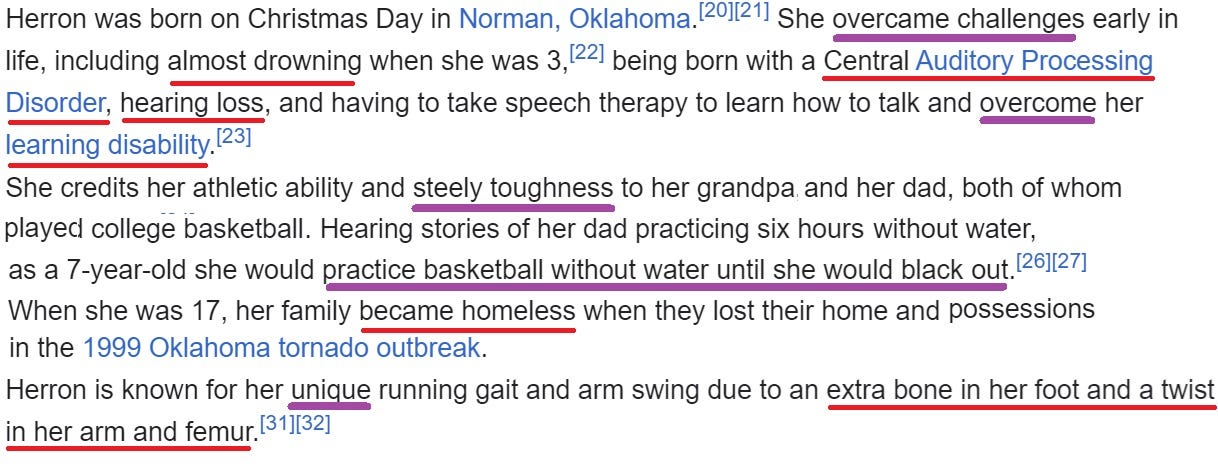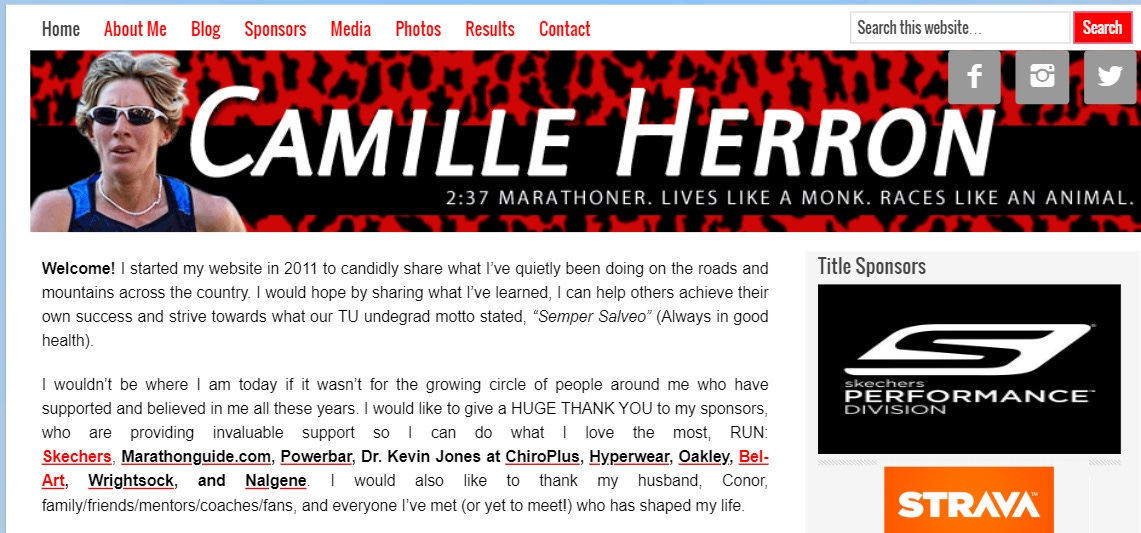Women's very-long-distance running made Camille Herron elite, not the other way around
The willingness to do anything for money and ego gratification ultimately kneecaps even the best image-management efforts, which Herron's are not
On Wednesday, 41-year-old American long-distance star Camille Herron decided it was time to take credit for boosting the evidently booming popularity of women’s ultramarathon running. As is often the case with Herron, she used the accomplishments of others as an excuse to crow about herself while perhaps not realizing how insincere any humility she projects appears.
The specific prompt for this outburst appeared to be Japanese runner Miho Nakata breaking Herron’s four-year-old 24-hour record on December 1 by covering 270.363 kilometers (167.996 miles) on a 2-kilometer loop in Taipei.
Herron’s strategy of portraying herself as a game-changer was clearly effective on social media, and Herron herself was clearly happy about this effectiveness.
As accomplished a runner as Herron is, and as lavishly as her name now peppers world-record lists, she did not invent high-performance very-long-distance women's running—and that’s without acknowledging that Herron is known mainly for pursuing excellence in limited areas of the discipline; think flat surfaces and pacing goals rather than strictly competitive aspirations, although the Comrades Marathon is certainly an exception. In fact, a Japanese athlete serving as the catalyst for Herron’s latest instance of Instagram self-stroking provides the easiest imaginable demonstration of that this idea is a farce, because it's fun to examine the hypothesis that without Herron in the mix, Nakata might not have found the power to run as far as she did in day a little over a week ago.
Does this idea apply to Naoko Takahashi, who in 2001 became the first sub-2:20:00 female marathoner in history? Herron was 19 years old then.
Or if we're just talking about ultras, does the “needed a white American chick for inspiration” hypothesis apply to Tomoe Abe, who set a still-standing 100-km road best in 2000, when Camille was 18?
What about Sumie Inagaki, who between 2006 and 2012 was a two-time Spartathon, Badwater, and IAU 24-Hour Run World Championship winner?
And in terms of contemporary accomplishments by others, does Herron really want to take credit for Taiwanese runner Tswi Wen-Ya setting a new record in at the Sri Chinmoy 3,100-mile race in October?
As is typically the case with athletes who pretend to be humble, Herron pretends to have no innate physical talent whatsoever. But with her false humility being especially boisterous, her claims of being unathletic are similarly absurdist, basically one step above “I was born as little more than a sputtering human head with flailing vestigial limbs, but look at me now.” I’m surprised Herron’s Wikipedia page doesn’t collapse into an unpretentious first-person narrative considering who clearly maintains it.
Despite her catastrophic childhood challenges, Herron won multiple high-school state championships in Oklahoma. In an interview with Runner’s World in October 2011, Herron—then “merely” a marathoner with a personal best a 2:38:23 who had earned minor fame by winning a number of minor marathons—was preparing to run the 2011 Pan Am Games Marathon and noted that she had recently run 5K and 10K personal bests of 16:46 and 34:39. Those remain her best marks at those distances, although World Athletics has an issue with the course the 34:39 (actually 34:40) was run on and lists 36:05, also from 2011, as her personal 10K best on her athlete profile.
That 2:38:23, meanwhile, was 69 seconds slower than the apparent lifetime best Herron would set less than three months later at the 2012 Olympic Team Trials in Houston, where Herron’s 2:37:14 placed her 26th. It’s interesting to consider that the “A” standard for qualification at the time, 2:37:00, is now needed simply to get into the Trials—especially in light of grousing from harpies like Alison Wade and grifters like Good for a Girl author Lauren Fleshman that the sport isn’t built to allow female runners to thrive.

The Runner’s World interview invited readers to check out the website Herron had created earlier that year. As the live site is long gone, the provided link now leads to an archived snippet of Herron’s site from 2015.
I had already become aware of Herron and her website because at the time I was coaching someone else associated with MarathonGuide.com’s racing team. I noticed that her race reports were littered with more excuses—both before and after races, even ones that had gone well—than any accounts I had ever read by anyone who had reached at least the sub-elite level. It seems plausible that the background material at the beginning of the Runner’s World interview—which noted Herron’s victories at the ”rainy” Napa Valley Marathon and the “warm and humid” Fargo Marathon that year—came directly from descriptions of these events on Herron’s blog.
At some point, Herron uploaded an athletic resume to her site’s server without linking it to anything, meaning that she probably didn’t want the world to see it yet, if at all. This document was rich in language accompanying every one of her personal bests testifying that the weather was in some way problematic. Unfortunately for Herron, Google’s search-bots enjoy indexing even “orphaned” files they discover crawlable webservers, and anyone who searched for Herron’s name was likely to find her athletic resume along with the website agnostic to its presence. And many people did.
Athlinks.com is a website consisting of an apparently self-indexing database of running-event performances. Anyone who finds their own race results there can claim these results and put them on his or her profile page. This profile can be set to “public” or “private.” People who don’t want others to know about any of their race results can claim every result as it appears while keeping their profiles private, while those who exclude the stinkers but want the world to see the good results simply leave those results “unclaimed.”
This is what Herron started doing as soon as people became interested in her c. 2011 self-promotion, and it’s what she does today. A search for her name under “unclaimed results” reveals everything Herron wants you to see, whereas she’s kept 166 races results hidden from public view.
In July 2014, Herron explained on the Letsrun message board that she does this not to try to hide her race results per se, but to try to prevent faster people from knowing about the races at which she was winning prize money. She also explained that she’s a very candid person who only started her website because some stranger on the Internet demanded this of her.
The claim that Herron was concerned about winning prize money as early as 2001, when she was 19 and a collegian reportedly struggling with chronic stress fractures, isn’t convincing. After all, she went on to claim on the same post that she was a “19 min. 5K recreational runner” for a while, perhaps referring to the cross-country times that earned her All-Oklahoma status three times in cross-country as a high-schooler.
Another thing you should know about Herron is that she considers herself to be a scientist or at least a scientific thinker. In reality, she can’t even do basic arithmetic, although she might be capable of this without her own ego bellowing things like “Make a 2:37 look better! MAKE A 2:37 LOOK GREAT!” in her face as she performs her calculations.
Herron stopped “putting it all out there” and being candid when she not only deleted her website but excluded it from the Wayback Machine so that no one could go rummaging through the electronic remains. The Google Document she links to, however, “Comparing Genders in the Marathon,” is still live.
You can ignore everything Herron claims here and the document she cooked up, because it’s not hard to see how much better a 2:13:12 marathon is for men than a 2:37 is for women. This was already true in 2014, but consider what Herron is claiming: That by some useful measure, she was as good as a 2:13:12 guy despite being over 18 percent slower.
How might Herron convert a 2:11:53 marathon by a woman into an equivalent man’s time? 18 percent faster than this is 1:51:42, and that seems like it might be a few years off even for Kelvin Kiptum, whose world record is 2:00:35.
She’s also incorrect about the rarity of fast runners with marathon times faster than their half-marathon times might predict. 2:37/1:16 = 157/76 = 2.066. Kiptum, whose half-marathon best is 58:42, has an even lower marathon-to-half-marathon performance ratio—2.054. American women’s marathon record-holder Emily Sisson, a 1:06:52/2:18:29 athlete, comes in at barely higher than Herron with a 2.071. When Keira D’Amato ran 2:19:12 in January 2022 to set the record Sisson broke this year, she was coming off a new half-marathon best of 1:07:55. That’s a slender 2.050 ratio, although in July of this year D’Amato dropped her half-marathon best to 1:06:39, also an American record.
Actually, Herron might want to note the fact that while outstanding runners who overperform at the marathon might be seen as intelligent about their training, it’s far more likely they’ll be seen as being on EPO and other performance-enhancing drugs. Surely Herron would not want to import the specter of possible widespread doping from the filthy-ass track and roads into the mostly pristine and peaceful mountains-ultras-trails (MUT) sector.
By far the most annoying thing about Camille Herron, however, is her graceless belly-flop into the muck of social-justice grifting and supporting racism toward white people. In addition to being sponsored by Lululemon, among the most laughably pretentious and demoralized fitness-apparel companies on the planet, Herron is associated with some Switzerland-based outfit called the Professional Trail Running Association.
On Friday, this group tweeted that, after three straight years of nonstop, undeserved handouts—to hundreds of boys masquerading as girls and men masquerading as women in female-only sports, to people pretending “they” have no gender at all while setting women’s national records, to drunken and dissembling gluttons of color pretending to be athletes, to openly racist imbeciles (or alternatively, cognitively limited racists), and to at least one highly regarded crotch-fondling climate-fraud who of course hangs around children—it was time for even more handouts and more anti-white racism to help kick these gimmies free from the grasp of whatever companies are still hoarding them.
These Diversity Guidelines have been a joke from the start, but there is nothing at all funny about these thieves and screeching losers anymore. Like Herron, these people will do anything for money no matter how patently fraudulent or disruptive their actions are.
Start here:
Anti-racism should be a core value, with active steps taken to dismantle systemic racism in the sport.
The proper response to this is a caustic and abrupt invitation for the person offering this nonsense to fellate you on the spot, whether you possess a phallus—real, imaginary, or grafted-on—and regardless of the other person’s gender and perhaps whimsical presentation thereof.
“Anti-racism” is nothing more than racism toward white people, with the biggest exploiters of this syphilitic money-spigot, fittingly, being lazy, weak, dumb, and increasingly tubby dimwits of Ivy League privilege. Even as these sleazebags continue lobbing grenades into the running milieu from ever further away from it, they continue to gain universal media acclaim for their hateful and dishonest efforts. Look no further (that’s literal advice) than Strava’s “Wear in Sport 2023 Awards,” a veritable asylum of known liars, scam-clowns, wide-bodied do-nothings, self-mutilating dopers, and—as if to emphasize the middle-finger the unnamed blue-haired, corncob-humping Strava employees who refuse to step forward and claim responsibility for these choices every December love waggling at decency—even includes a transgender race-car driver.
But yeah, companies should give these bloated and stank-bootied crybabies and social arsonists yet more free, unearned swag.
The next time a “white” person tells you he or she is “anti-racist,” assume they hate themselves, are dumber than a bucket of piss, and don’t have to work for a living; they next time you hear this from a “nonwhite” person, assume it’s equal parts anti-white hatred and standard grifting.
It’s also essential to understand what these chortling, anti-human gadabouts mean by “diversity” and “inclusion.” It’s very simple: They want a diversity of skin colors and genders and hair colors that includes only low-IQ people who think in the same pathological ways they do. They want nothing more than for running to universally consist of a multicolored and hyperfaggified army of hideous-looking people, but at least all of its soldiers would be Nazis. That’s it.
And “equity” means handouts, nothing more. Lying slobs, capering trannies and feckless “nonbinary” posers, and ostentatious middle-aged drag-queens aren’t worried that they are not currently getting freebies, and that these should; they’re worried that the insane money-train already tearing through the sport might stop running one day.
Let’s hope so. It’s time to tell all of these rotten and poisonous fruits of forced Wokism to find another aspect of culture to stain with their character evils while exploiting for personal gain.
And it would be funny if some bored Ethiopian female sub-2:20 marathoner in the twilight of her career decided it was time to pay more attention to Herron’s exhortations to grow women’s ultrarunning and spend a year or two shattering all of Herron’s records just to show how weak they are. And they clearly are. What you have here is someone who maxed out at 2:37 for the marathon, is constitutively eager to run a ton of miles at a very slow pace, has an enormous ego, and is sufficiently deluded about how many people care about ultras to nourish that ego by jogging for unusually long periods.
Herron sets records on flat roads and tracks. Her biggest fear isn’t that women’s ultrarunning isn’t popular enough, it’s that something might change the incentives one day to make it popular among more people who are actually world-class athletes instead of steely survivors of several childhood nuclear wars.









